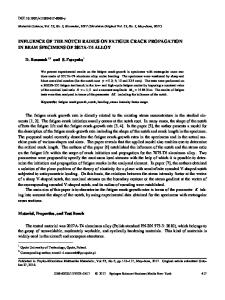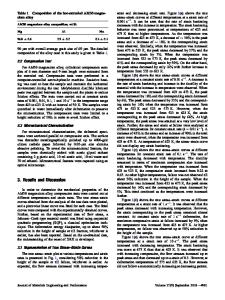Notch Impact Behavior of Oxide-Dispersion-Strengthened (ODS) Fe20Cr5Al Alloy
- PDF / 2,116,925 Bytes
- 14 Pages / 593.972 x 792 pts Page_size
- 58 Downloads / 355 Views
I.
INTRODUCTION
OXIDE-DISPERSION-STRENGTHENED (ODS) steels produced by mechanical milling and hot isostatic pressing (HIP) are considered as potential structural materials for future fusion reactors because dispersion strengthening appears to be the most promising approach to widening the operating temperature window of the actual ferritic steels.[1,2] The requirements for fusion reactors, sodium fast reactors (SFRs), very-high temperature reactors (VHTRs), super critical water reactors (SCWRs), or other GEN IV nuclear energy systems are different, but generic development can be considered for the materials. Due to their high creep rupture strength and excellent swelling resistance, ferritic ODS materials can be used in several types of reactors, and many developments concerning this type of alloys are in progress.[3–5] One of the common key issues for using ODS ferritic steels as a structural material for the advanced fission and fusion nuclear systems is to improve the lower fracture toughness over conventional or reduced-activation ferritic steels.[6] In addition, Alinger et al.[7] reported an anisotropic behavior in the fracture toughness of the hot-extruded MA957 ODS ferritic steels and suggested that the low toughness will be improved by J. CHAO, Head, C. CAPDEVILA and J.A. JIMENEZ, Researchers, and G. PIMENTEL, Ph.D. Student, are with the Department of Physical Metallurgy, Centro Nacional de Investigaciones Metal´urgicas (CENIM-CSIC), 28040 Madrid, Spain. Contact e-mail: ccm@cenim. csic.es M. SERRANO, Researcher, and A. GARCIA-JUNCEDA, Research Assistant, are with the Structural Materials Division, Technology Department, CIEMAT, Avda de la Complutense 22, 28040 Madrid, Spain. E. URONES-GARROTE, Researcher, is with the Universidad Complutense de Madrid, Centro Nacional de Microscopı´ a Electro´nica (CNME), 28040 Madrid, Spain. Manuscript submitted December 5, 2012. Article published online June 27, 2013 METALLURGICAL AND MATERIALS TRANSACTIONS A
the elimination of stringer-like alumina inclusions from impurities in the source powder. On the other hand, Kasada et al. revealed the existence of elongated M23C6 in two types of hot-extruded ODS ferritic steels (Fe19Cr-4Al-2W-0.3Ti-0.3Y2O3 and Fe-19Cr-0.3W-0.3Ti0.3Y2O3) containing a relatively high concentration (0.05 to 0.09 wt pct) of impurity carbon.[8] All these results lead us to conclude that the morphology of brittle features in the ODS ferritic steels depends on multiple factors that could lead to the formation of undesirable particles: not only by the chemical compositions and fabrication process but also the impurity level and situation of raw powder. In this article, the combination of the microstructural factors such as the effective grain size, texture, and oxide distribution on notch impact behavior of the Fe20Cr6Al0.5Y2O3 hotrolled tube has been investigated.
II.
MATERIALS AND EXPERIMENTAL TECHNIQUES
The ODS Fe19Cr5.5Al0.5Y2O3 alloy was commercially available as PM 2000 and manufactured by Plansee GmbH (Lechbruck, Germany) as reported elsewhere.[9
Data Loading...











